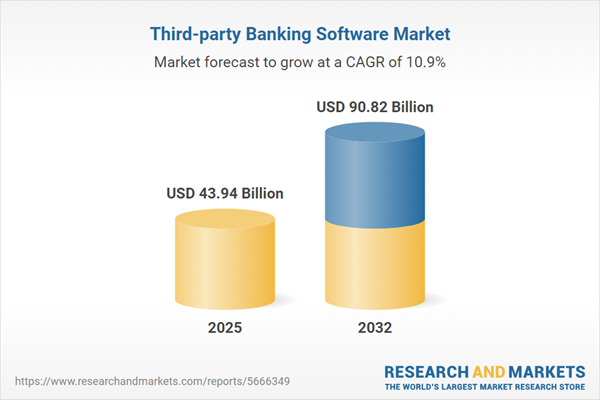Speak directly to the analyst to clarify any post sales queries you may have.
Senior financial executives face growing complexity as digital transformation and regulatory frameworks reshape the industry. In this climate, the third-party banking software market stands out as a strategic lever for advancing innovation, operational agility, and compliance.
Market Snapshot: Third-Party Banking Software Market
The third-party banking software market is undergoing significant growth, reaching a value of USD 39.65 billion in 2024, with an anticipated expansion to USD 43.94 billion in 2025 at a compound annual growth rate (CAGR) of 10.91%. By 2032, projections indicate the market will achieve USD 90.82 billion. This momentum is propelled by a surge in financial organizations adopting cloud-native and API-first solutions to modernize legacy infrastructure, form new collaborative ventures, and rapidly address regulatory priorities. Banks, credit unions, and fintech organizations are leveraging these trends to diversify product offerings, strengthen customer relationships, and deepen interaction with technology partners. As a result, the third-party banking software market now plays a pivotal role in digital transformation strategies across the global financial services sector.
Scope & Segmentation of the Third-Party Banking Software Market
The scope of this report is tailored to senior decision-makers seeking clear, actionable guidance for technology planning and regulatory risk mitigation, covering diverse organizational needs and operational realities across geographies and institution types. The segmentation reflects real-world market drivers and strategic requirements.
- End User Segments: Banks prioritize solutions that strengthen compliance and enhance client engagement; credit unions focus on risk management and process efficiency; multinational financial organizations need robust software infrastructures to scale across borders; smaller institutions seek modular systems for agile expansion of digital services.
- Geographical Coverage: Includes the Americas, Europe, Middle East, Africa, and Asia-Pacific markets. The analysis highlights how varying regulatory standards, levels of digital adoption, and local customer expectations impact software procurement trends and implementation strategies.
- Leading Vendors: Providers such as Fidelity National Information Services, Finserv, Finastra, Temenos, Oracle Financial Services Software, SAP, Avaloq, Jack Henry & Associates, Intellect Design Arena, and Tata Consultancy Services deliver comprehensive banking software. Their offerings address a broad variety of financial institution needs, supporting global and regional business models alike.
- Core Technologies: Market innovation centers on cloud-native, modular architectures, API-first frameworks, open banking interfaces, AI-driven workflow automation, and microservices. These technologies enable financial organizations to boost compliance, streamline daily processes, and facilitate integration with evolving digital ecosystems.
Key Takeaways for Senior Decision-Makers
- Robust third-party banking software allows financial institutions to continuously adjust compliance strategies and enhance operational flexibility in response to shifting regulations and market conditions.
- Collaboration with established technology vendors empowers organizations to shift more internal focus toward growth initiatives and innovation by accessing specialized capabilities externally.
- Deploying advanced software architectures supports faster integration and more agile development cycles, accelerating delivery of digital financial products while minimizing operational impacts.
- Ongoing evaluation of vendor performance and long-term support commitments helps reduce technology risk and ensures business continuity during major system changes.
- Prompt software updates aligned with changing compliance obligations are vital to risk management and help maintain organizational momentum during periods of expansion.
- Modular and scalable platforms position institutions to adapt rapidly to emerging industry trends and evolving customer demands, thereby strengthening resilience in volatile environments.
Tariff Impact on Global Software Supply Chains
Recent U.S. tariff adjustments are driving financial organizations to reexamine software sourcing strategies. As a result, there is a growing emphasis on compliance with regional data protection frameworks and an uptick in investments in domestically hosted cloud solutions. By balancing local regulatory requirements with concerns about reliability and operational efficiency, institutions are better positioned to manage external risks across their technology environments.
Research Methodology & Data Sources
This independent evaluation synthesizes expert input from executive interviews, targeted IT leader surveys, and validation by sector specialists. The rigor of this approach ensures that senior executives gain practical, evidence-based guidance to support technology and procurement decisions in a complex and dynamic marketplace.
Why This Report Matters
- Helps executive teams establish resilient procurement frameworks tailored to evolving technology risks and compliance landscapes.
- Supports benchmarking against market peers in technology adoption, providing leadership with insights for targeted digital investment and continuous improvement.
- Equips organizations to anticipate the regulatory changes and accelerate digital transformation for future-ready operational stability.
Conclusion
This report offers senior financial professionals actionable insights to lead digital transformation, reinforce technology partnerships, and preserve operational continuity through periods of regulatory change and market evolution.
Additional Product Information:
- Purchase of this report includes 1 year online access with quarterly updates.
- This report can be updated on request. Please contact our Customer Experience team using the Ask a Question widget on our website.
Table of Contents
3. Executive Summary
4. Market Overview
7. Cumulative Impact of Artificial Intelligence 2025
Companies Mentioned
The companies profiled in this Third-party Banking Software market report include:- Fidelity National Information Services, Inc.
- Fiserv, Inc.
- Finastra Group Holdings Ltd
- Temenos AG
- Oracle Financial Services Software Limited
- SAP SE
- Avaloq Group AG
- Jack Henry & Associates, Inc.
- Intellect Design Arena Limited
- Tata Consultancy Services Limited
Table Information
| Report Attribute | Details |
|---|---|
| No. of Pages | 184 |
| Published | November 2025 |
| Forecast Period | 2025 - 2032 |
| Estimated Market Value ( USD | $ 43.94 Billion |
| Forecasted Market Value ( USD | $ 90.82 Billion |
| Compound Annual Growth Rate | 10.9% |
| Regions Covered | Global |
| No. of Companies Mentioned | 11 |









